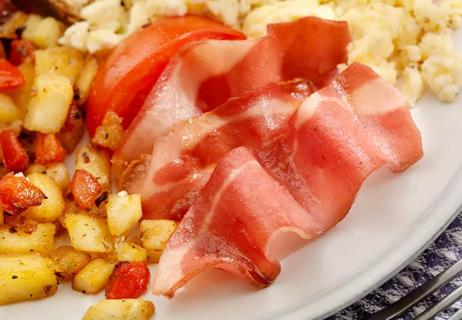Despite what you may have heard, pork is actually red meat (and it comes with the same risks as other red meats)

You might’ve learned that pork is red meat. But maybe you’ve also learned that pork is white meat. Both can’t be true, right?
Advertisement
Cleveland Clinic is a non-profit academic medical center. Advertising on our site helps support our mission. We do not endorse non-Cleveland Clinic products or services. Policy
There’s only one real answer, as confirmed by the United States Department of Agriculture: Pork is a type of red meat, even though it’s sometimes pale in color when cooked.
Let’s dig deeper into what it means to be classified as red meat and whether pork is a healthy choice.
“Pork is a red meat,” confirms registered dietitian Julia Zumpano, RD, LD. “The concept of pork as white meat was part of a marketing campaign that began in the 1980s, but in the realm of health and nutrition, it is considered a red meat.”
Pork is pig meat and falls into the livestock category, which includes lamb, veal and beef — all red meat. But what does that even mean? Zumpano explains that meats are categorized as either white or red based on the amount of myoglobin found in an animal’s muscle.
“Myoglobin is a protein found in meat that produces a red color when it’s exposed to oxygen,” she explains. “Poultry and fish, which are both considered white meat, have significantly less myoglobin than red meat.”
Like other red meat, pork has some health benefits — and some health risks, especially if you eat it frequently or in large quantities.
“Pork is a source of high-quality protein and also contains a number of nutrients,” Zumpano says, “but it’s also a source of saturated fat and cholesterol, so it should be limited in terms of how often you eat it and how much of it you eat.”
Advertisement
A quick look at the benefits of pork:
Pork is high in both saturated fat and sodium (salt), which have been linked to an increased risk for cardiovascular diseases, or diseases that affect your heart and blood vessels.
“Saturated fats are found in many animal-based foods, including meat and dairy,” Zumpano says, “and they’ve been linked to an increase in LDL, or ‘bad’ cholesterol, which can lead to coronary artery disease.”
The American Heart Association says calories from saturated fat shouldn’t make up more than 6% of your daily calories. If you consume 2,000 calories a day, that means 120 calories or fewer should come from saturated fat, which comes out to 13 grams of saturated fat per day. One serving of ground pork alone has more than 12 grams of saturated fat.
And don’t forget about all the sodium.
“Because most pork is processed, it contains high amounts of sodium, which can cause increases in blood pressure and lead to heart disease and stroke,” Zumpano adds.
To be clear, eating a porkchop for dinner or having two slices of bacon at brunch every now and then isn’t going to lead to cancer. But there is a clear and proven connection between red meat and cancer, and that includes pork — especially processed pork products.
Let’s back up: Carcinogens are substances that may cause cancer in humans — and red meat is thought to be one of them. After extensive research, the International Agency for Research on Cancer (IARC) has classified red meat as a Group 2A carcinogen, which it describes as “probably carcinogenic to humans.”
In particular, red meat is thought to increase your risk of colorectal cancer. And one review showed that pork consumption is more closely connected to an increased risk of rectal cancer than other types of red meat.
There’s more: The IARC classifies processed meat as a Group 1 carcinogen, which means it’s known to be carcinogenic to humans. That puts bacon and sausage in the same category as tobacco and alcohol!
Both pork and beef are red meat, and they have similar health benefits and risks. What really matters, Zumpano says, is the cuts of meat you choose and how often you eat them.
You should limit your red meat consumption to no more than 3 ounces per week, which comes out to one to two servings per week. People with heart disease or high cholesterol should eat even less. And the cut of the pork is important, too.
Advertisement
When you’re choosing any type of red meat, you should always go for the leanest cut possible.
“In terms of availability, you may find it easier to find lean cuts of beef at the grocery store when compared to lean cuts of pork, but the most important thing to remember is to choose the leanest cut available,” Zumpano reiterates. “Also, consider organic pork, when possible.”
Organic meats, she says, provide more nutrients with lower exposure to added growth hormones, antibiotics and pesticides when compared to conventional meat.
Avoid inherently fatty cuts of pork, including ham, pork shoulder, pork belly and spareribs. Again, instead look to the leanest cuts of pork, like:
“Always cut off any visible fat off before you eat it,” Zumpano adds.
And finally: What about bacon?
We’ve got bad news: All processed meats, including processed pork products, are on the “skip” list, due to their high fat and salt content and their carcinogenic status. That list includes bacon, sausage, ham, hot dogs, salami and deli meats.
If you love pork, you don’t have to give it up — but as with other types of red meat, it’s best to limit how much of it you eat in terms of both frequency and quantity.
Advertisement
“Although pork does provide nutrients, consider choosing skinless poultry and fish for excellent sources of protein and nutrients without the added risks,” Zumpano suggests.
Advertisement
Learn more about our editorial process.
Advertisement

Risks of this restrictive eating plan include digestive issues, heart disease and cancer

While uncured bacon is preserved differently, it’s still processed meat and poses similar risks as cured bacon

Eating red and processed meats can raise your risk of developing certain types of cancer

It has nutrients your body needs, but it also comes with some serious health risks

Packed with iron, vitamin A and protein, beef liver provides a healthy low-calorie meat option

Organ meat is packed with nutrients, but it’s not good for everyone

They’re classified as carcinogenic because of their link to cancer

As with traditional pork bacon, eat it sparingly

If you’re feeling short of breath, sleep can be tough — propping yourself up or sleeping on your side may help

If you fear the unknown or find yourself needing reassurance often, you may identify with this attachment style

If you’re looking to boost your gut health, it’s better to get fiber from whole foods